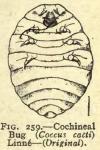 The dried female insect, Coc'cus cac'ti Linné. (Fam. Coccidae), enclosing the young larvae.
The dried female insect, Coc'cus cac'ti Linné. (Fam. Coccidae), enclosing the young larvae.
HABITAT.—Mexico, Central America, and Northern South America (originally), and Spain and Algiers (introduced); feeds on various cacti, especially upon Opuntia coccinilifera.
COLLECTION.—Only the females (wingless) are used; they are brushed off from the food-plant, and, if alive, are killed by heat (hot water or oven). The cochineal insect is cultivated on a large scale, and large quantities are annually exported from Mexico and Peru. Humboldt estimated that 800,000 pounds of coccus (each pound representing 70,000 insects) were annually imported into Europe.
DESCRIPTION.—The females (which alone are used) are small, wingless, oval, dull purplish-brown insects, convex above, about 4 mm. (1/6 in.) long, covered, when alive, with a white cottony secretion. When the insects are dead and dry, this "cotton" rubs off, and the crushed insects yield a dark red powder; odor faint, taste slightly bitter.
VARIETIES.—These are: (1) silver, recognized by the presence of a soft, silvery white powder contained in the furrows and wrinkles; it appears to be a fatty substance as it melts on the application of heat, and the insects lose their silvery appearance. This variety is said to be the mature and fecundated insect. (2) Black cochineal, of a reddish-black color, nearly devoid of silvery powder, is supposed to be the female exhausted by propagation. (3) Granilla, an inferior kind composed of small and imperfect insects.
ADULTERATION.—The silvery gray variety with carbonate or sulphate of barium and lead; the black cochineal with graphite, ivory black, or manganese dioxide. "When completely incinerated, cochineal should leave not more than 5 per cent. of ash."
CONSTITUENTS.—Cochineal contains principally a red coloring matter soluble in water, alcohol, or water of ammonia. This coloring matter is composed of carminic acid, C17H18O10 (?).
Carminic acid is obtained by treating the drug first with ether to remove fat, then with alcohol. Let alcoholic solution stand a few days, when carminic acid will deposit as a brownish-purple substance. A vermilion-red powder (carmine), soluble in water, alcohol, and alkalies, is obtained as a combination of this acid with alumina or occasionally with oxide of tin or with albumen. Commercial carmine is made by precipitating the decoction of cochineal with alum or cream of tartar.
MEDICAL PROPERTIES.—Cochineal has some reputation as an anodyne and antispasmodic, but it has not for many years been used as a remedial agent, its chief use being that of a coloring matter, and for this purpose it enters into the following preparation.
- OFFICIAL PREPARATION.
- Tinctura Cardamomi Composita (0.5 per cent.) Dose: 1 fl. dr. (4 mils).

